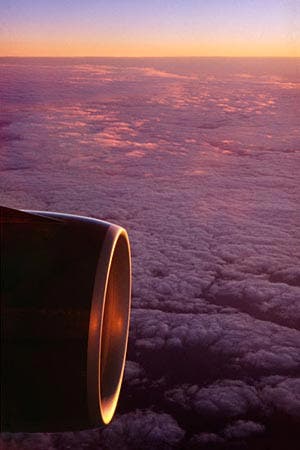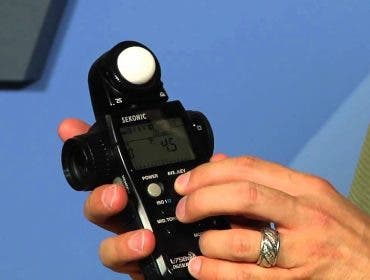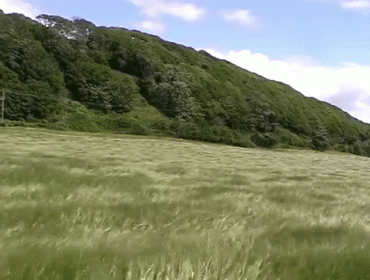100 in 100: Taking pictures from Airliners
*Enter New Author
Adorama ALC
 For more tips, go to the 100 in 100 Part III HomepageAirplanes provide some unique photo opportunities. You can get some wonderful shots from the air, and at airshows and airports (with permission) you can shoot airplanes on the ground and in flight. As with any type of photography, there are ways to maximize your chances of success. Each day this week I’ll look at a different aspect of this subject. Today we’ll look at shooting from airliners.Where to sit (a window would be a good start)Know where your flight route will go – will you fly over the Grand Canyon or Iceland? Obviously you want to be on the side of the plane where the best scenery will be and in a window seat. But flight routes can vary, and it may be hard to know where the scenery will be. In this case go for the shady side. The window is made of layers of thick plastic and especially if it is dirty, sunlight shining on it can make it like shooting through waxed paper.If the plane has engines mounted on the wing you want to be ahead of the wing if possible, as exhaust will create heat waves behind the wing. Focus and exposure Be sure the camera focuses on the scenery and not the window. If you’re using a compact camera, use landscape mode. Another way to minimize the chance of focusing on the window is to get the camera as close to it as possible. Getting your compact camera or DSLR close to the window will also help minimize any reflections from lights or bright objects inside the plane. But don’t let the camera or even your arm touch anything that is vibrating. You always want to isolate a camera from movement and vibration.If you have a polarizer it may not be a lot of help as the plastic in the window can interfere and cause color patterns. And be sure to turn the flash off. If it fires it will illuminate the plastic and any dirt or moisture on the window and will spoil your picture. For more tips, go to the 100 in 100 Part III HomepageAirplanes provide some unique photo opportunities. You can get some wonderful shots from the air, and at airshows and airports (with permission) you can shoot airplanes on the ground and in flight. As with any type of photography, there are ways to maximize your chances of success. Each day this week I’ll look at a different aspect of this subject. Today we’ll look at shooting from airliners.Where to sit (a window would be a good start)Know where your flight route will go – will you fly over the Grand Canyon or Iceland? Obviously you want to be on the side of the plane where the best scenery will be and in a window seat. But flight routes can vary, and it may be hard to know where the scenery will be. In this case go for the shady side. The window is made of layers of thick plastic and especially if it is dirty, sunlight shining on it can make it like shooting through waxed paper.If the plane has engines mounted on the wing you want to be ahead of the wing if possible, as exhaust will create heat waves behind the wing. Focus and exposure Be sure the camera focuses on the scenery and not the window. If you’re using a compact camera, use landscape mode. Another way to minimize the chance of focusing on the window is to get the camera as close to it as possible. Getting your compact camera or DSLR close to the window will also help minimize any reflections from lights or bright objects inside the plane. But don’t let the camera or even your arm touch anything that is vibrating. You always want to isolate a camera from movement and vibration.If you have a polarizer it may not be a lot of help as the plastic in the window can interfere and cause color patterns. And be sure to turn the flash off. If it fires it will illuminate the plastic and any dirt or moisture on the window and will spoil your picture.  If the light level is low you want a high enough ISO to allow a shutter speed fast enough that camera shake will not blur the picture. But with compact cameras, higher ISOs will cause noise in the image. Steady the camera as much as possible and press the shutter very carefully and smoothly.And don’t just think ground-based scenery. The view of clouds, sunrises and sunsets from six miles up can be spectacular. For inspiration check out the book, Window Seat by Julieanne Kost. It is about much more than the photographs, recounting how she found a creative outlet that fit into a hectic travel schedule. Diane Miller is a widely exhibited freelance photographer who lives north of San Francisco, in the Wine Country, and specializes in fine-art nature photography. Her work, which can be found on her web site, www.DianeDMiller.com, has been published and exhibited throughout the Pacific Northwest. Many of her images are represented for stock by Monsoon Images and Photolibrary. She is also an accomplished pilot. Previous | Next © 2008 Adorama Camera, Inc. If the light level is low you want a high enough ISO to allow a shutter speed fast enough that camera shake will not blur the picture. But with compact cameras, higher ISOs will cause noise in the image. Steady the camera as much as possible and press the shutter very carefully and smoothly.And don’t just think ground-based scenery. The view of clouds, sunrises and sunsets from six miles up can be spectacular. For inspiration check out the book, Window Seat by Julieanne Kost. It is about much more than the photographs, recounting how she found a creative outlet that fit into a hectic travel schedule. Diane Miller is a widely exhibited freelance photographer who lives north of San Francisco, in the Wine Country, and specializes in fine-art nature photography. Her work, which can be found on her web site, www.DianeDMiller.com, has been published and exhibited throughout the Pacific Northwest. Many of her images are represented for stock by Monsoon Images and Photolibrary. She is also an accomplished pilot. Previous | Next © 2008 Adorama Camera, Inc.
|
 For more tips, go to the 100 in 100 Part III HomepageAirplanes provide some unique photo opportunities. You can get some wonderful shots from the air, and at airshows and airports (with permission) you can shoot airplanes on the ground and in flight. As with any type of photography, there are ways to maximize your chances of success. Each day this week I’ll look at a different aspect of this subject. Today we’ll look at shooting from airliners.Where to sit (a window would be a good start)Know where your flight route will go – will you fly over the Grand Canyon or Iceland? Obviously you want to be on the side of the plane where the best scenery will be and in a window seat. But flight routes can vary, and it may be hard to know where the scenery will be. In this case go for the shady side. The window is made of layers of thick plastic and especially if it is dirty, sunlight shining on it can make it like shooting through waxed paper.If the plane has engines mounted on the wing you want to be ahead of the wing if possible, as exhaust will create heat waves behind the wing. Focus and exposure Be sure the camera focuses on the scenery and not the window. If you’re using a compact camera, use landscape mode. Another way to minimize the chance of focusing on the window is to get the camera as close to it as possible. Getting your compact camera or DSLR close to the window will also help minimize any reflections from lights or bright objects inside the plane. But don’t let the camera or even your arm touch anything that is vibrating. You always want to isolate a camera from movement and vibration.If you have a polarizer it may not be a lot of help as the plastic in the window can interfere and cause color patterns. And be sure to turn the flash off. If it fires it will illuminate the plastic and any dirt or moisture on the window and will spoil your picture.
For more tips, go to the 100 in 100 Part III HomepageAirplanes provide some unique photo opportunities. You can get some wonderful shots from the air, and at airshows and airports (with permission) you can shoot airplanes on the ground and in flight. As with any type of photography, there are ways to maximize your chances of success. Each day this week I’ll look at a different aspect of this subject. Today we’ll look at shooting from airliners.Where to sit (a window would be a good start)Know where your flight route will go – will you fly over the Grand Canyon or Iceland? Obviously you want to be on the side of the plane where the best scenery will be and in a window seat. But flight routes can vary, and it may be hard to know where the scenery will be. In this case go for the shady side. The window is made of layers of thick plastic and especially if it is dirty, sunlight shining on it can make it like shooting through waxed paper.If the plane has engines mounted on the wing you want to be ahead of the wing if possible, as exhaust will create heat waves behind the wing. Focus and exposure Be sure the camera focuses on the scenery and not the window. If you’re using a compact camera, use landscape mode. Another way to minimize the chance of focusing on the window is to get the camera as close to it as possible. Getting your compact camera or DSLR close to the window will also help minimize any reflections from lights or bright objects inside the plane. But don’t let the camera or even your arm touch anything that is vibrating. You always want to isolate a camera from movement and vibration.If you have a polarizer it may not be a lot of help as the plastic in the window can interfere and cause color patterns. And be sure to turn the flash off. If it fires it will illuminate the plastic and any dirt or moisture on the window and will spoil your picture.  If the light level is low you want a high enough ISO to allow a shutter speed fast enough that camera shake will not blur the picture. But with compact cameras, higher ISOs will cause noise in the image. Steady the camera as much as possible and press the shutter very carefully and smoothly.And don’t just think ground-based scenery. The view of clouds, sunrises and sunsets from six miles up can be spectacular. For inspiration check out the book, Window Seat by Julieanne Kost. It is about much more than the photographs, recounting how she found a creative outlet that fit into a hectic travel schedule. Diane Miller is a widely exhibited freelance photographer who lives north of San Francisco, in the Wine Country, and specializes in fine-art nature photography. Her work, which can be found on her web site, www.DianeDMiller.com, has been published and exhibited throughout the Pacific Northwest. Many of her images are represented for stock by Monsoon Images and Photolibrary. She is also an accomplished pilot. Previous | Next © 2008 Adorama Camera, Inc.
If the light level is low you want a high enough ISO to allow a shutter speed fast enough that camera shake will not blur the picture. But with compact cameras, higher ISOs will cause noise in the image. Steady the camera as much as possible and press the shutter very carefully and smoothly.And don’t just think ground-based scenery. The view of clouds, sunrises and sunsets from six miles up can be spectacular. For inspiration check out the book, Window Seat by Julieanne Kost. It is about much more than the photographs, recounting how she found a creative outlet that fit into a hectic travel schedule. Diane Miller is a widely exhibited freelance photographer who lives north of San Francisco, in the Wine Country, and specializes in fine-art nature photography. Her work, which can be found on her web site, www.DianeDMiller.com, has been published and exhibited throughout the Pacific Northwest. Many of her images are represented for stock by Monsoon Images and Photolibrary. She is also an accomplished pilot. Previous | Next © 2008 Adorama Camera, Inc.



